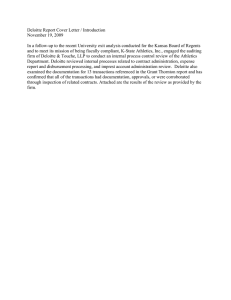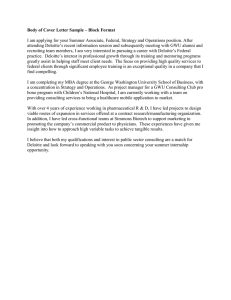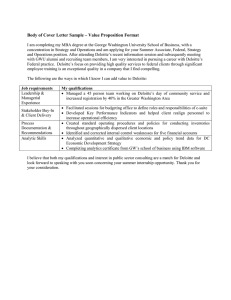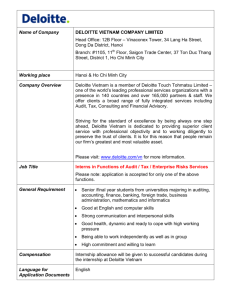Field Service Optimization
advertisement
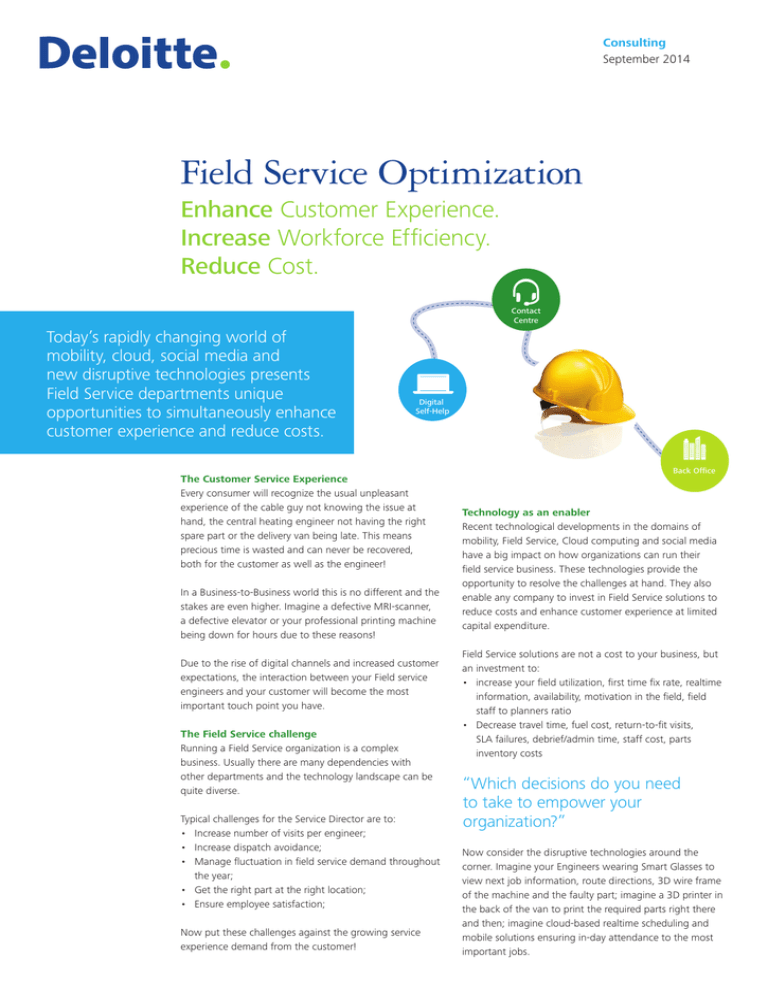
Consulting September 2014 Field Service Optimization Enhance Customer Experience. Increase Workforce Efficiency. Reduce Cost. Contact Centre Today’s rapidly changing world of mobility, cloud, social media and new disruptive technologies presents Field Service departments unique opportunities to simultaneously enhance customer experience and reduce costs. Digital Self-Help The Customer Service Experience Every consumer will recognize the usual unpleasant experience of the cable guy not knowing the issue at hand, the central heating engineer not having the right spare part or the delivery van being late. This means precious time is wasted and can never be recovered, both for the customer as well as the engineer! In a Business-to-Business world this is no different and the stakes are even higher. Imagine a defective MRI-scanner, a defective elevator or your professional printing machine being down for hours due to these reasons! Due to the rise of digital channels and increased customer expectations, the interaction between your Field service engineers and your customer will become the most important touch point you have. The Field Service challenge Running a Field Service organization is a complex business. Usually there are many dependencies with other departments and the technology landscape can be quite diverse. Typical challenges for the Service Director are to: • Increase number of visits per engineer; • Increase dispatch avoidance; • Manage fluctuation in field service demand throughout the year; • Get the right part at the right location; • Ensure employee satisfaction; Now put these challenges against the growing service experience demand from the customer! Back Office Technology as an enabler Recent technological developments in the domains of mobility, Field Service, Cloud computing and social media have a big impact on how organizations can run their field service business. These technologies provide the opportunity to resolve the challenges at hand. They also enable any company to invest in Field Service solutions to reduce costs and enhance customer experience at limited capital expenditure. Field Service solutions are not a cost to your business, but an investment to: • increase your field utilization, first time fix rate, realtime information, availability, motivation in the field, field staff to planners ratio • Decrease travel time, fuel cost, return-to-fit visits, SLA failures, debrief/admin time, staff cost, parts inventory costs “Which decisions do you need to take to empower your organization?” Now consider the disruptive technologies around the corner. Imagine your Engineers wearing Smart Glasses to view next job information, route directions, 3D wire frame of the machine and the faulty part; imagine a 3D printer in the back of the van to print the required parts right there and then; imagine cloud-based realtime scheduling and mobile solutions ensuring in-day attendance to the most important jobs. It is not just technology… …that makes the difference. For a full understanding of a Field Service business it is important to analyze both the strategic and operational layers of your business and the relationship between the two. Ensure you first answer key questions which drive the way you look at e.g. product selling or value add services; product and spare parts life cycle; customer relationship and data collection. Next, you can look at your operational challenges and define the right approach to resolve them. Whichever direction you choose at strategic and operational level, in the end it is all about the people. Especially in Field Service environments where you are dealing with many departments, different cultures and potential big changes to a workforce used to more traditional ways of working. Understanding the business: Before identifying business issues, we need to understand 1 Value Delivery Model How is the mobile workforce positioned? As a customer service differentiator, revenue generator, asset maintainer or necessary evil? Is it a blend? This understanding will help frame our analysis and recommendations 2 In-house versus Outsource 3 4 Contractuals Which activities are performed in-house and which are outsourced and why? Which contractual frameworks are used? This will help us understand what levers we can and can not use and how we can access benefits This will define and help us understand the business drivers Organizational Model Are regional or functional organizations used and why? Has there been any recent organizational restructuring? This will allow framing of hypothesis and recommendations Understanding the issues and requirements: Once the strategic positioning and delivery model have been confirmed and understood, we can align the analysis and the resulting recommendations of the operational effectiveness of the process, with the business structure and strategic intend 5 Symptoms and Metrics Through interviews with the client front-line team and management, as well as field job shadowing, we will identify and document the visible business symptoms Strategic 6 7 Maturity Study Comparing the current business practices and symptoms with our benchmark maturity study, we can identify improvement areas and set target maturity levels 8 Diagnostic We will take a hypothesis lead diagnostic to clarify the size and scale of the issues and quantify the benefits available Project Scoping Based on this diagnosis we will formulate a plan to address the identified opportunities Operational Deloitte approach We propose an eight step approach to enable us to effectively understand your business as well as the support it may require. The outcome of this initial study will be insights into: • How well you do on the maturity ladder; • Your potential cost savings and increase in customer experience; and • The next steps to realize your potential. Using our in depth knowledge of all aspects of Field Service (Scheduling, Mobility, Supply Chain, Security, Change, Training) and vision on disruptive technologies, we will ensure your Service organization is ready for the future. Contact Wiechert Stevens Senior Manager Mobile: +31 6 12 34 44 77 Email: wstevens@deloitte.nl Jeroen Panken Senior Manager Mobile: +31 6 12 58 17 36 Email: jpanken@deloitte.nl Deloitte refers to one or more of Deloitte Touche Tohmatsu Limited, a UK private company limited by guarantee (“DTTL”), its network of member firms, and their related entities. DTTL and each of its member firms are legally separate and independent entities. DTTL (also referred to as “Deloitte Global”) does not provide services to clients. Please see www.deloitte. nl/about for a more detailed description of DTTL and its member firms. Deloitte provides audit, tax, consulting, and financial advisory services to public and private clients spanning multiple industries. With a globally connected network of member firms in more than 150 countries and territories, Deloitte brings world-class capabilities and high-quality service to clients, delivering the insights they need to address their most complex business challenges. Deloitte’s more than 200,000 professionals are committed to becoming the standard of excellence. This communication contains general information only, and none of Deloitte Touche Tohmatsu Limited, its member firms, or their related entities (collectively, the “Deloitte network”) is, by means of this communication, rendering professional advice or services. No entity in the Deloitte network shall be responsible for any loss whatsoever sustained by any person who relies on this communication. © 2014 Deloitte The Netherlands

